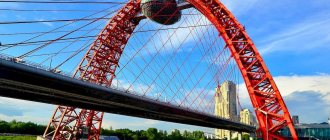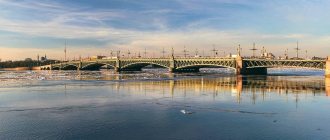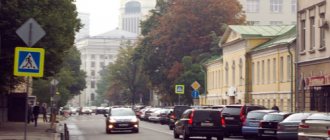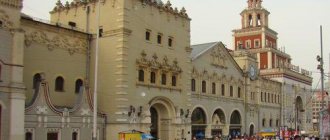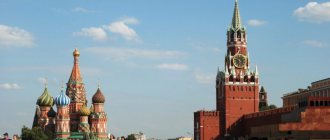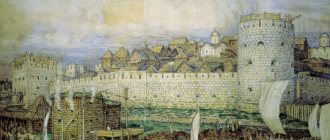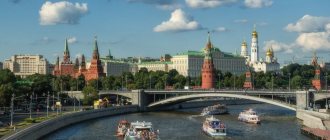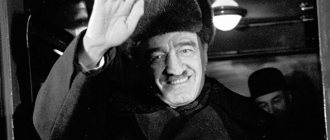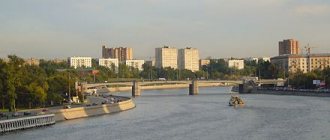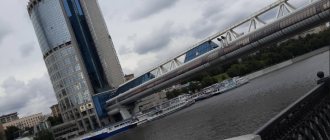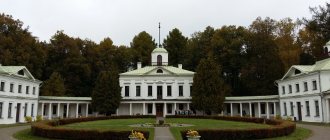Moscow Street, whose name was given by the Kuznetsky Bridge over the Neglinka, filled with tons of soil back in the century before last, is historical, incorporating the settlements of artisans of the 12th century and the luxury of the Silver Age.
Kuznetsky Most Street is especially loved by Muscovites for its architectural color and amazing stories associated with famous people who are somehow related to this place. In each of the windows you can see a reflection of that era: fashionistas, carriages and the first cars. They say that the main shopping street of the Russian capital was once known as a trendsetter, an avid theatergoer and a social goddess.
Recently it has been pedestrianized. It hosts festivals and festive events with installations around the entire perimeter of famous old mansions and the new buildings that replaced some of them.
Let us also walk along the pre-revolutionary paving stones so that, like Pushkin, we will be surprised at how everything has changed again on this stretch of Moscow, just under a kilometer long.
History of Kuznetsky Most Street
The street got its name from the bridge of the same name. At first it was wooden, later stone, across the Neglinnaya River. The very origin of the name of the street as “Kuznetskaya”, as well as the name of the bridge across the river, is associated by historians with the Kuznetsk settlement located here and the foundry center created in the 15th – 16th centuries.
Initially, this street was a symbol of luxury and was famous for its trading houses. The Moscow nobility, literally “close” to the Tsar, lived there. However, even in modern times a certain amount of sybaritism has been preserved. The street is part of a semicircle around the Moscow Kremlin and today remains one of the main promenades in the historical center of Moscow.
Many buildings on Kuznetsky Most today are cultural monuments at the federal and regional level. They witnessed the destinies of famous cultural and historical figures. Each of them, despite its uniqueness and originality, is organically combined with other buildings and together they create a surprisingly picturesque ensemble of old Moscow. Let's talk about these objects in a little more detail.
Popov Passage
This is one of the most remarkable buildings on Kuznetsky Most. Initially, in its place was the mansion of Count Vederevsky. The building changed hands several times and survived several fires. At the end of the 19th century, the house was bought by the merchant Popov, who demolished it to the ground and built an arcade where numerous shops were located.
After the revolution, the building was confiscated, and it housed various government agencies, and later a scientific and technical library. At the moment, the building is being reconstructed, and it is planned to open a large department store in it.
Apartment building Sokol
Starting our promenade along the Kuznetsky Bridge, we immediately notice a structure in the Art Nouveau style with an attic and majolica mosaic, different from the nearby three-four-story buildings. House No. 3 on Kuznetsky Most is called “Apartment House Sokol”. It's hard to make a mistake - the architect Ivan Pavlovich Mashkov specially positioned the house in such a way that it can be seen from afar. A beautiful ceramic panel on the figured attic of the house has been preserved. The author of the mosaic sketch, depicting an eagle soaring above the ground, was the artist Nikolai Nikolaevich Sapunov.
The date of construction of the apartment building is 1904. The lower floors were rented out by the owner M.V. Falcon for trading offices. The upper ones, with fashionable rooms, became the residence of famous cultural figures, famous persons of their era. Today, government and commercial institutions are located here.
Apartment house of Mr. Khomyakov
Further along the even side of the street at the intersection with Petrovka there is house number 6, in which the filming of the lyrical comedy “Office Romance” directed by Eldar Ryazanov took place. This building, known as the Khomyakov Apartment House, was built in the Art Nouveau style in 1900 and is considered a rare example of that era.
The corner part of the building with its bay window and display windows is especially picturesque. In the historical past, on the first floors here there were offices and trading shops, a private bank, and a bookstore selling rare publications. The upper floors of the house were used to house residents. Now the Federal Agency for River and Sea Transport Management is located here.
Restaurant "Yar"
Many historical figures saw the walls of the building erected by the architect Kaminsky in 1878 at the intersection of Kuznetsky Most and Neglinnaya streets, this is house number 9. Regulars came to it to visit the French restaurant located here, which was especially popular among the creative intelligentsia. It was named in honor of the owner of the restaurateur Tranquil Yard and remained in the history of the city under the name “Yar”. Apparently the spirit of the past predetermines the present, and today this building houses a restaurant, although not French cuisine, but oriental cuisine as a tribute to modern fashion, and a hookah bar popular among young people is also open here.
Kuznetsky Bridge
Once upon a time, on the steep slopes of the left bank of the Neglinnaya River there was a settlement, which was inhabited by blacksmiths exempt from state service. That’s why the bridge built across the water barrier was called Kuznetsky, and the Moscow street now bears the same name. And residents and guests of the capital, walking along its sidewalks, sometimes do not even suspect that somewhere under their feet there is an old stone bridge. And only periodic construction work reminds us of this.
Story
At first the bridge was built of wood. It is known that it was washed away several times during floods caused by rapid melting of snow. And in the middle of the 18th century. it was replaced by a stone three-span structure. The author of the project for the new Kuznetsky Bridge was Prince V.D. Ukhtomsky, who held the position of chief architect of Moscow during the reign of autocrat Elizaveta Petrovna. The stone crossing across the Neglinka was almost 30 meters long, and taking into account the fortified and fenced approaches, which were designed for significant river floods, its length reached almost a hundred meters, stretching from Petrovka to Rozhdestvenka.
Over time, it was decided to enclose the left tributary of the Moscow River in an underground pipe. The work was carried out during 1818 – 1819. When Neglinka was imprisoned in a man-made structure, the street level rose significantly and exceeded the height of the Kuznetsky Bridge. The stone bridge structure was not demolished, but the fences were simply removed from it and covered with soil. Thus, the bridge turned out to lie under the cover of one of the main Moscow streets, which was famous for its many shops and stores.
About the events of 1986
In 1986, some residents and guests of the capital were lucky enough to see with their own eyes fragments of the historical structure of the Kuznetsky Bridge. Work on the construction of a new collector was carried out in this area. During excavation work, workers stumbled upon the bridge structures, damaging the stone parapet with construction equipment. The work was suspended, and restoration architects got down to business. The necessary measurements, fixation and architectural conservation of the structure were carried out. The opinion of the experts was unanimous: the technical condition of the old building allows it to be restored and become another architectural and historical object in the capital. However, then the road surface was restored, which again hid the structure of the old bridge from human eyes.
A few words about Kuznetsky Most street
Kuznetsky Most is one of the oldest streets in Moscow; many interesting architectural monuments have been preserved here. These are the buildings of city estates and mansions of noble noble families, the San Galli passage, where today the artist’s house is located, the building of the Solodovnikov Theater, which today houses the Moscow Operetta Theater, former trading and apartment buildings, passages and many other architectural structures representing the objects cultural heritage of both regional and federal significance.
And just like for several centuries today, Kuznetsky Most is still the main street of fashionable boutiques, shops and restaurants.
Trading house A.M. Mikhailova
On the even side of the street, in house No. 14, you can see a fashionable facade with a large glass area. This is the “Trading House A.M. Mikhailov", the building was purchased by a merchant of the first guild in 1880. Having started his career as a boy in a store, Alexey Mikhailovich Mikhailov grew to become the owner of a fur empire - a network of factories and stores.
The author of the project for a four-story fur factory on Kuznetsky was the architect Barkov. But at the beginning of the 20th century, according to the design of another famous Moscow architect Erichson, a new facade overlooking the street was erected. Red granite was used in the construction of the first floor, the columns are made of black labradorite and decorated with bronze. The decorative modern elements on the upper floors of the building look elegant - stucco molding and openwork grilles.
After the death of A.M. Mikhailov in 1916, his factory became the property of the Soviet state. From 1940 until 2002, the building was used as the nationally known “House of Models”, which served the top officials of the Soviet era. Now the house has not lost its affiliation with high fashion - it houses premium segment stores.
How Kuznetsky Most became the most fashionable street in Moscow
In St. Petersburg, Nevsky Prospekt, the main thoroughfare, can be found even with your eyes closed. Moscow, with its radial-ring structure in the 19th century, could not yet distinguish it, they wrote in the guidebooks. All roads are good, choose according to your taste. But Kuznetsky Most became a center of fashion and trade already in the 18th century, and for a long time no one could challenge the status of this “sanctuary”.
Kuznetsky Most bends twice under the influence of Petrovka and Rozhdestvenka, radial streets extending from the Kremlin. “Kuznetsky Most was not like any other Moscow street. He is hunchbacked and goes down a steep slope, causing slight dizziness; Every now and then he gives surprises: suddenly the Chinese Wall opens in the clear, but it seemed to me that it was in another part of the world,” wrote Yuri Nagibin. In the Middle Ages, this area was called Neglinnaya Verkhov due to the proximity of a large tributary of the Moscow River. At the end of the 15th century, Ivan III built a Cannon Yard on its bank, where artillery was made for the Russian army and bells were cast. The manufactory was built by Aristotle Fioravanti. Kuznetsky Bridge was the largest crossing over the Neglinka in this area, and in the 1750-1760s. it was updated by Semyon Yakovlev according to the design of the architect Dmitry Ukhtomsky. The bridge became white-stone, three-span, its width reached 12 meters, and its length - 120. Other Moscow engineering structures were much more impressive than city streets! But already at the beginning of the 19th century, the crossing no longer existed, because Neglinka was hidden underground. “It’s funny that they will say: I went to the Kuznetsky Bridge, but he was gone, like a “green dog,” wrote Moscow postmaster A.Ya. Bulgakov. In the enlightened age, projects were hatched to build a canal here with ponds, waterfalls and a statue of Catherine II on the shore. But the authorities preferred to “drain” Neglinka, because there were already a lot of ponds and rivers in the city center. The bridge, as Moscow old-timers assured, was “pretty bad.”
I went to Kuznetsky Bridge, but he was gone, like a “green dog”
From the second half of the 18th century, the Kuznetsky Bridge acquired a pronounced gallant connotation. Morals softened, the Russian aristocracy began to enjoy balls and receptions, and society acquired a taste for the good life. And the owners of the Kuznetsky Bridge, of course, were not Russian merchants and “capitalist” men who were just gaining strength, but foreigners. At first, Jews and Germans ruled the roost here, and by the end of the 18th century the French won a landslide victory. Since then, “simpler” trade was concentrated within Kitay-Gorod, and gentlemen and ladies in their own carriages visited the Kuznetsky Bridge. Fashion Street has become an important phenomenon in the life of Moscow. Kuznetsky Most will not lose its high status by the beginning of the 20th century; it will only acquire competitors and transform into a street of banks, arcades and restaurants. However, the textbook heyday of Kuznetsky was the 1820-1830s, when Griboyedov’s Famusov exclaimed:
And all the Kuznetsky Bridge, and the eternal French, From there fashion comes to us, and authors, and muses: Destroyers of pockets and hearts!
The influx of French emigrants increased sharply after the revolutionary events of the 1790s that rocked Western Europe.
Many French residents saw Russia as a source of firm power and steadfastness. The French lived in a compact colony in the area of Furkasovsky Lane, where their first Catholic church was dedicated to Saint Louis IX. In the 18th century, Muscovites voiced their intention to “go to French shops,” and already in the 19th century the expression “to go to the Kuznetsky Bridge” became established. It is reasonable to assume that most of the signs on the shopping street were made in French. Moscow Governor-General F.V. Rostopchin tried to fight the ingrained tradition. He continually banned signs in foreign languages or evicted traders from Moscow. In his essay “Thoughts out loud on the Red Porch of the Russian nobleman Sila Andreevich Bogatyrev,” which appeared in 1807, Rostopchin endows one of the heroes with a revealing tirade: “Lord, have mercy! All you see is young people dressed and wearing shoes in French style; and French in word, deed and thought. Their fatherland is on the Kuznetsky Bridge, and their kingdom of heaven is Paris. Parents are not respected, old people are despised and, having been nothing, they want to be everything. There are philanthropists and misanthropes. Philanthropists love people, but they ruin men; misanthropes flee from human society to taverns. The old women and the young went crazy. Everything became a mess. They run to marry the French and abhor the Russians.” However, in 1812, Napoleonic troops entered the city and took the shops of their compatriots under protection; trade on Kuznetsky was not affected.
All you see is young people dressed and wearing shoes in French style; and French in word, deed and thought. Their fatherland is on the Kuznetsky Bridge, and the kingdom of heaven is Paris
Rostopchin's efforts were nullified. Already in the 1810s, French enterprise again flourished in full bloom. The capital's elite gathered here, dates were made, P. Wistenhof describes the “cosmetics” shops located here. Kuznetsky was visited by “mostly one very cleanly dressed people, because the Moscow commoner, having no need for anything that is sold on the Kuznetsky Bridge, passes through it unless absolutely necessary.” According to everyday life writers of the mid-19th century, “...a dandy and a dandy go with a purpose and without a purpose to the Kuznetsky Bridge, an idle Moscow youth, who almost lives in a phaeton, prowls the streets without any need.”
Moscow fashionistas are not used to skimping, so the guidebooks noted with some reproach: “Everything is exorbitantly expensive; but for our fashionistas this is nothing: the word bought on Kuznetsky Most gives each thing a special charm.” Of the eighteen shops located on the street in 1826, only one belonged to a Russian owner. “Forbidden” signs are gradually returning. Pushkin confidentially informs his wife in 1833: “Important news: the French signs destroyed by Rostopchin in the year you were born have appeared again on Kuznetsky Most.”
However, sometimes justice dropped in on the main shopping street: “Back in the 19th century, funny episodes of punitive police justice took place on the Kuznetsky Bridge - and at such hours crowds of people flocked here to see elegant young ladies in hats and silk dresses and dandies in Zimmermans on heads with brooms in their hands swept the sidewalks - such police corrective measures at that time punished violators and violators of public decency, as well as fans of alcohol.” The police tried to teach a lesson to the gallant gentlemen and their ladies who had arrived at the police station the day before. Those who were guilty were painted a circle with a cross inside on their clothes and the idlers were sent from the neighborhood straight to Kuznetsky.
Love affairs also happened here. At the corner of Petrovka and Kuznetsky Most, back in the 1940s, one could admire the mansion of the Annenkov family. The ancient manor was decorated with a rotunda. A resident of the house, the future Decembrist Ivan Annenkov, fell in love with a Frenchwoman, Polina Gebl, who worked in the Dumancy fashion store and in 1823 accepted an offer to move to Moscow. Polina went to Siberia to find her fiancé. Alexandre Dumas described their relationship in the novel The Fencing Teacher. The Annenkov house was demolished immediately after World War II. On the opposite side of Petrovka, the curious will look at the lovingly restored sign “K.F. Depre Wine Trade Partnership.” Napoleonic warrior Camille Despres was wounded on the Borodino field. He was nursed by nurse Anna Riess. Despres fell in love with his savior, proposed to her and stayed in Russia. The wine house became a stable source of income for the new family. In the 1810-1820s, many Frenchmen, who were grooms, gardeners and servants in their homeland, sought their fortune in Russia. In Moscow they could earn relatively easy money. The descendants of the French who started their business on the Kuznetsky Bridge were lawyer A.F. Koni and historian Yu.V. Gauthier.
In the 1860s, gas lighting came to the street. Shops, restaurants and pastry shops multiplied. The bourgeoisie began to come here. Bank offices and shopping arcades rose up. Kuznetsky Most entered the capitalist era without great losses. In its middle part, ancient paving stones have been preserved to this day.
Pavel Gnilorybov, Moscow historian, coordinator of the Mospeshkom project
Passage F.C.San Galli
The House of Artists, which today is located in Moscow at Kuznetsky Most, 11, is a historical building of the late 19th century, created by the architect Alexei Alexandrovich Martynov. The house is distinguished by a beautiful arch-shaped vault, which united the buildings of the merchant Sveshnikov that previously existed on this site. In 1880, the owner of the passage became a German-born entrepreneur, Franz Karlovich San Galli. Throughout the history of its existence, various retail establishments were located here, but they had one thing in common - belonging to the highest trading segment. Schröder pianos were sold in the arcade, there was the Palais Royal, a famous jewelry store, and many famous French brands were represented.
As with most historical buildings on Kuznetsky Most, the passage is characterized by the preservation of historical traditions. The trade and exhibition pavilions of San Galli have retained their purpose. Exhibitions are still held within these historical walls, combining two contradictory, but going hand in hand trends - commerce and creativity.
After the October Revolution
In the first years after the establishment of Soviet power, most of the buildings on Kuznetsky Most were confiscated and transferred to various government agencies and organizations. The second life of the street began during the NEP period, when enterprising citizens were again allowed to develop trade. However, the title of the main fashion center of the country was returned to this place when the All-Union House of Models was opened in house No. 14, for which Kuznetsky Most is still famous.
After this event, Moscow, thanks to the designers working there, became known in the world as a place where special fashion with a Russian soul is created.
Tretyakov Trading House
Built by architect Alexander Stepanovich Kaminsky in 1892 by order of famous philanthropists, the Tretyakov Apartment House is recognized as a cultural monument. Experts attribute this building to the pseudo-Russian style. According to the tradition of that historical period, the first floors had a commercial purpose. The Tretyakovs rented out part of the building, located on Rozhdestvenka, to the Lyon Credit bank; other premises were intended for retail shops and the sale of goods to artists.
Later, already under Soviet rule, government and trade organizations were located in this house. At first it was the publishing house of the magazine "October", later - the commissariat, the city and federal prosecutor's offices. After the fire in 2008, the Tretyakov Trading House was completely restored and today looks as beautiful as it did a hundred years ago.
Moscow International Commercial and Industrial Bank L.S. Polyakov
The building, which can easily be called a street decoration and a symbol of elitism, is located at the intersection of Kuznetsky Most and Rozhdestvenka Street, at number 8/15. The façade of the house, built on the property that once belonged to Count Vorontsov, looks so flashy and pretentious that it can rightfully be considered the hallmark of the Kuznetsky Bridge.
In 1898, the famous financial tycoon L.S. Polyakov erected a building for the bank according to the design of S.S. Eibushitsa. The facade, designed in the Roman Baroque style with cladding from Radom sandstone, impresses with its pomp. In 1901, the Quisisano restaurant was opened in one of its premises, which anticipated the modern technological boom - an attempt was made to organize customer service through automatic serving of dishes. "Commercial and Industrial Bank L.S. Polyakov" predetermined the fate of the building. Over the years, financial institutions have been located here and currently the office of one of the largest banks is located here.
Trading house "I. V. Juncker and Co.
House No. 16/5. It is classified as an architectural example of Moscow neoclassicism. This is a cultural heritage monument, protected by the state and known as the Trading House “I.V. Juncker and Co.”
The building was built according to the plans of the architect Peter Santinovich Campioni in 1876. Later, in 1900 and again in 1908, the trading house was completely reconstructed by the no less famous Erichson in the Moscow Art Nouveau style, and it became neoclassical after reconstruction by the architect Eramishantsev and the Vesnin brothers already in 1916.
Now on the facade of the building, directly above the sculptural image of the head of Mercury, there is a sign “Federal Bailiff Service”, an amazing combination of symbols of the time.
Apartment house of Prince A.G. Gagarin
Walking along the Kuznetsky Bridge, it is difficult not to notice house No. 19, with the facade of the building decorated with picturesque stucco, with an impressive glazing area, at the top of which you can see a high relief in the shape of a boat with an anchor. The stucco molding depicts the attributes of Mercury, the god of trade.
This apartment building with shops belonged to Prince Gagarin. The princely estate did not acquire its completed form immediately; the participation of various craftsmen was required. Built according to Kossov's design in 1886, the building received its further development ten years later in the work of the architect Klein. Now it houses the Kuznetsky Most passage and fashion boutiques.
Pedestrian streets of Moscow
Today in Moscow there are about 20 pedestrian streets only in the center of the capital, completely free from traffic, not counting those created in other areas of the city:
| Arbat, street | Bolshoi Tolmachevsky Lane |
| Resurrection Gate, passage | Kamergersky Lane |
| Klimentovsky Lane | Kremlevsky proezd |
| Crimean embankment | Kuznetsky Most, street |
| Lavrushinsky Lane | Manezhnaya street |
| Nikolskaya street | Horde dead end |
| Pushkinskaya embankment | Pyatnitsky Lane |
| Stoleshnikov Lane | Tverskoy proezd |
| Tretyakovsky proezd | Bolotnaya embankment |
| Cosmonauts, alley | Larch Alley |
For your convenience, the pedestrian streets of Moscow are marked on the city map:
Profitable ownership of I.I. Vorontsova - I.G. Evdokimova - Z.I. Shorina
The former profitable estates occupy an entire block between Neglinnaya and Petrovka streets; such a scale was achieved through the purchase of 40 plots of land by Count Vorontsov. During the NEP years, it was in this building that the Moskovsky Rabochiy publishing house was located, to which young M.A. Sholokhov brought the manuscript of his novel “Quiet Don”.
Thus, the amazing past of each historical object on Kuznetsky Most Street predetermined its present. Morals and fashion change, but something remains that is not subject to time, this is the spirit of history. The modern appearance of Moscow is only a new version of the past, its history, embodied in architectural and cultural monuments.
Our acquaintance with the historical pedestrian zone is indicated quite dottedly - special cultural places that have received state protected status are marked. In fact, this is only a visible part of the history of the street; there are a lot of legends, urban legends and historical evidence that are revealed at the moment of deeper acquaintance with it. To get to know them, you just need to take the metro to the Kuznetsky Most station and allow yourself to immerse yourself in the historical past and renewed present of one of the oldest streets in Moscow.
Modern look
Today, in the vicinity and on the Kuznetsky Most street itself (a district of Moscow limited by Teatralny Proezd and Bolshaya Dmitrovka and Rozhdestvenskaya streets) there are many famous cultural and educational institutions, starting with the Bolshoi Theater and the Technical Library and ending with the School named after. Shchepkina.
At the same time, it continues to be the place where the most famous shops of the capital are concentrated. These include the completely renovated Central Department Store, the Svetlana Trading House, the 4-story Podium store, etc. This ancient street is also famous for its attractions, which deserve a separate description.
